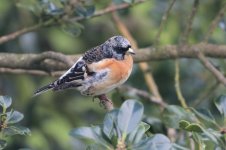Having waded through all 69 pages of the first draft of the St Aidan's plan, I can't say I'm too optomistic about the RSPB's impending takeover. There is far too much emphasis on stuff like delivery and visitor experience and not enough about birds for my liking. That said, it is always going to be a difficult site with regard to access (both legal and not).
I only hope that the hard work put into the area over many years is properly valued and given full credit.
So what's new. I haven't seen the plans, but I bet I can have a good guess.
I imagine that it will start with removing the hides and replacing them with glass structures that allow the birds full vision of everyone inside, designed by top-rated and top-priced archtitects and costing enough to manage the reserve for a decade. They will ensure that these have windows that don't open properly to prevent the use of scopes.
Next they will build a platform for people to feed the ducks in the middle of the reserve, thus attracting lots of people who have mistaken the reserve for a public park and use it to exercise their noisy kids, who run, jump and scream along what used to be quiet paths. While they are at it they will clear away most of the scrub and willow carr from around these paths so the birds can't miss the screaming kids and to make sure that biodiversity is reduced by about 50 per cent, along with breeding populations.
Next they will fell every bush within a mile radius 'so that crows can't nest in them'. This will make sure that cuckoos abandon the reserve as they have no look out posts.
They will then see if there are any decades-old LEO roosts in the neighbouring hedges, and be sure to fell these hedges at the first opportunity. They will make especially certain to do this if the roost can be observed from a hide without any risk of disturbing the owls.
If there are any mature trees near the visitors' centre thay will fell these too for good measure. If any of them contain a little owl, clearly visible to the public, they will open a conference centre next to so that it gets scared away to an area the puiblic are not allowed. It's also imperative that they remember to build a classroom for school visits so that it blocks any view of neighbouring arable land where grey partridges feed.
Finally, they will raise the water levels during wader passage to ensure that no mud is visible. This will, they assure us, allow better breeding success of the local ducks. It's not like any site they manage used to be a major staging ground for passage waders before they came along.
And, finally, of course, they will ensure that birders can only visit after 10am, so we can't make early morning visits any more, when the birds are at their most active. They'll also lock up at 5pm in summer, because who'd want to bird after that?




